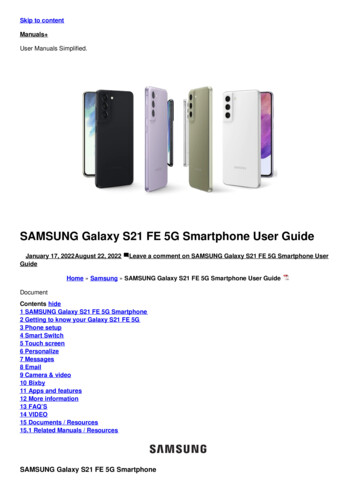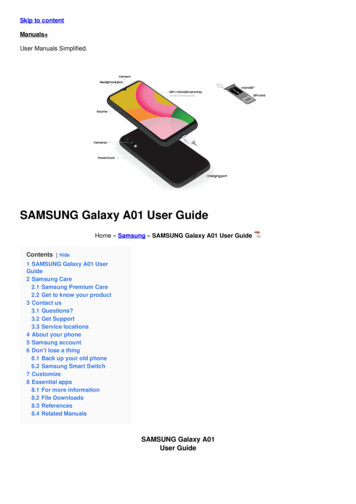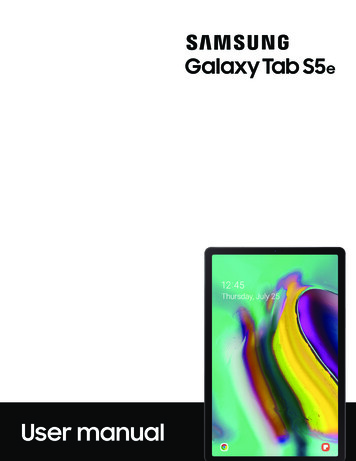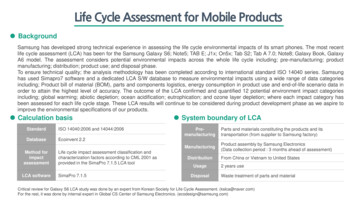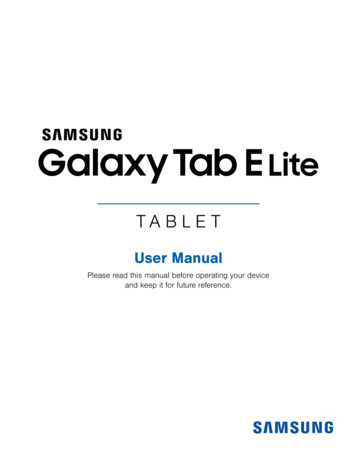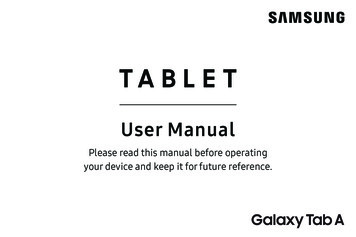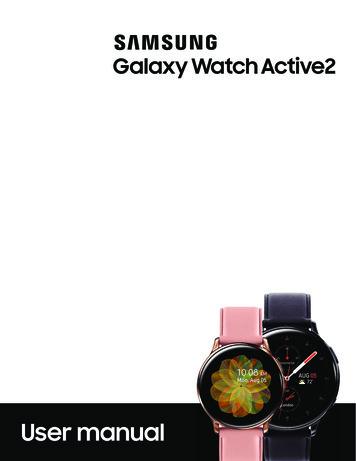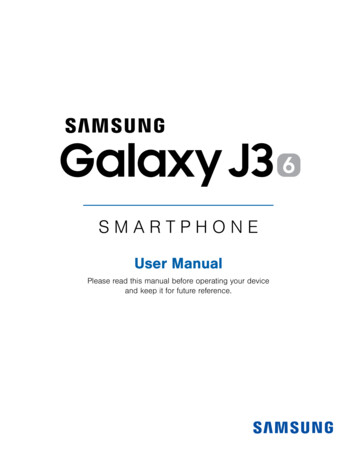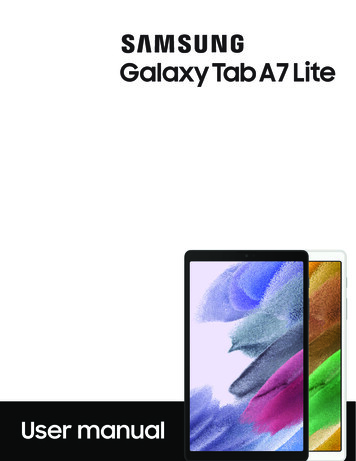
Transcription
SAMSUNGGalaxy Tab A7 LiteUser manual
ContentsFeaturesMobile continuity Biometric security Dark modeGetting startedDevice Layout: Tab A7 LiteSet up your device: Charge the batteryStart using your device: Turn on your device Use the Setup Wizard Transfer datafrom an old device Lock or unlock your device Side key settings Accounts Navigation Navigation bar Customize your home screen Digital wellbeing andparental controls Biometric security Mobile continuity Multi window Edge panels Enter textCustomize your home screen: App icons Wallpaper Widgets Home screen settings Status bar Notification panelCamera and GalleryCamera: Navigate the camera screen Configure shooting mode Record videos Camera settingsGallery: View pictures Edit pictures Play video Edit video Share pictures and videos Delete pictures and videos Take a screenshotMobile continuityContinue apps on other devicesSamsung appsGalaxy Store Game Launcher Samsung Flow Samsung Free Samsung TV Plus Calculator Calendar Clock Contacts Internet My Files Samsung Notes2SAM T220 T227 EN UM TN UE3 060721 FINAL
ContentsGoogle appsChrome Drive Duo Gmail Google Maps Photos Google Play Movies & TV PlayStore YouTube YT MusicMicrosoft appsOutlook Office OneDriveSettingsConnections: Wi-Fi Bluetooth Airplane mode Mobile networks Data usage Mobilehotspot Tethering Nearby device scanning Connect to a printer Virtual PrivateNetworks Private DNS EthernetCustomization: Display Notifications Sounds and vibrationSecurity: Lock screen and security Face recognitionAccounts: Add an account Account settings Remove an account Users Backup andrestore Google settingsBackup: Google Account External storage transferAccessibility: Recommended for you TalkBack Visibility enhancements Hearingenhancements Interaction and dexterity Advanced settings Installed services About AccessibilityOther: Help Android Auto About tabletLearn moreLegal information3
Getting startedTab A7 LiteSet up your deviceStart using your device4
Getting startedTab A7 LiteRear cameraFront cameraSide keyVolume keysHeadset jackSpeakerUSB charger/Accessory portMicrophoneDevices and software are constantly evolving — the illustrations you see here are for reference only.5
Getting startedSet up your deviceCharge the batteryYour device uses a nano-SIM card (unless it is the Wi-Fi model). A SIM card may bepreinstalled, or you may be able to use your previous SIM card. Contact your carrierfor more details.SIMmicroSDInstall SIM/microSD cardsPlace the SIM card andoptional microSD card(sold separately) intothe tray with the goldcontacts facing down.Charge your deviceBefore turning on yourdevice, charge it fully.NOTE The use of mobile devices on an aircraft or a ship may be subject to federaland local guidelines and restrictions. Check with appropriate authorities andalways follow crew instructions regarding when and how you may use yourdevice.Devices and software are constantly evolving — the illustrations you see here are for reference only.6
Getting startedNOTE Use only Samsung-approved chargers and cables. To avoid injury ordamage to your device, do not use incompatible, worn or damaged batteries,chargers or cables. Using other charging devices and batteries may void yourwarranty and may cause damage. For more information on your device,including charging compatibility, please visit samsung.com.Charge the batteryYour device is powered by a rechargeable battery.TIP While charging, the device and the charger may become hot and stopcharging. This usually does not affect the device’s lifespan or performance and isin the device’s normal range of operation. Disconnect the charger from the deviceand wait for the device to cool down. For more information, rt using your deviceTurn on your device Use the Setup Wizard Transfer data from an old device Lock orunlock your device Side key settings Accounts Navigation Navigation bar Customize your home screen Digital wellbeing and parental controls Biometricsecurity Mobile continuity Multi window Edge panels Enter textTurn on your deviceUse the Side key to turn your device on. Do not use the device if the body is cracked orbroken. Use the device only after it has been repaired. Press and hold the Side key to turn the device on. To turn the device off, press and hold the Side and Volume down keys at thePower off. Confirm when prompted.same time, and tap To restart your device, press and hold the Side and Volume down keys at theRestart. Confirm when prompted.same time, and tap7
Getting startedUse the Setup WizardThe first time you turn your device on, the Setup Wizard guides you through the basicsof setting up your device. Follow the prompts to choose a default language, connect to a Wi-Fi network, set upaccounts, choose location services, learn about your device’s features, and more.Transfer data from an old device Use Smart Switch to transfer contacts, photos, music, videos, messages, notes,calendars, and more from your old device. Smart Switch can transfer your data viaUSB cable, Wi-Fi, or computer.Visit samsung.com/smartswitch for more information.1. From Settings, tapAccounts and backup Bring data from old device.2. Follow the prompts and select the content to transfer.8
Getting startedLock or unlock your deviceUse your device’s screen lock features to secure your device. By default, the devicelocks automatically when the screen times out. For more information about screenlocks, see Lock screen and security.Side keyPress to lock.Press to turn onthe screen, andthen swipe thescreen to unlock it.Devices and software are constantly evolving — the illustrations you see here are for reference only.9
Getting startedSide key settingsYou can customize the shortcuts assigned to the Side key.Double pressChoose which feature is launched when the Side key is pressed twice.1. From Settings, tapAdvanced features Side key.2. Tap Double press to enable this feature, and tap an option:lQuick launch camera (default)lOpen appAccountsSet up and manage your accounts.TIP Accounts may support email, calendars, contacts, and other features.Contact your carrier for more information.Add a Google AccountSign in to your Google Account to access your Google Cloud Storage, apps installed from your account, and make full use of your device’s Android features.When you sign in to a Google Account and set a Lock screen, Google DeviceProtection is activated. This service requires your Google Account information whenresetting to factory settings. For more information, see Google Play Protect.1. From Settings, tap2. TapAccounts and backup Manage accounts.Add account Google.Add a Samsung accountSign in to your Samsung account to access exclusive Samsung content and make fulluse of Samsung apps. From Settings, tap Samsung account.10
Getting startedAdd an Outlook account Sign in to your Outlook account to view and manage email messages.1. From Settings, tap2. TapAccounts and backup Manage accounts.Add account Outlook.11
Getting startedNavigationA touch screen responds best to a light touch from the pad of your finger or acapacitive stylus. Using excessive force or a metallic object on the touch screen maydamage the surface of the screen and the damage will not be covered by thewarranty.TapLightly touch items to select or launch them.lTap an item to select it.lDouble-tap an image to zoom in or out.Devices and software are constantly evolving — the illustrations you see here are for reference only.12
Getting startedSwipeLightly drag your finger across the screen.lSwipe the screen to unlock the device.lSwipe the screen to scroll through the Home screens or menu options.Devices and software are constantly evolving — the illustrations you see here are for reference only.13
Getting startedDrag and dropTouch and hold an item, and then move it to a new location.lDrag an app shortcut to add it to a Home screen.lDrag a widget to place it in a new location.Devices and software are constantly evolving — the illustrations you see here are for reference only.14
Getting startedZoom in and outBring your thumb and forefinger together or apart on the screen to zoom in and out.lMove your thumb and forefinger apart on the screen to zoom in.lMove your thumb and forefinger together on the screen to zoom out.Devices and software are constantly evolving — the illustrations you see here are for reference only.15
Getting startedTouch and holdTouch and hold items to activate them.lTouch and hold a field to display a pop-up menu of options.lTouch and hold a Home screen to customize the Home screen.Devices and software are constantly evolving — the illustrations you see here are for reference only.16
Getting startedNavigation barYou may navigate your device by using either the navigation buttons or full screengestures.BackRecent appsHomeDevices and software are constantly evolving — the illustrations you see here are for reference only.17
Getting startedNavigation buttonsUse buttons along the bottom of the screen for quick navigation.1. From Settings, tapDisplay Navigation bar Buttons.2. Tap an option under Button order to choose which side of the screen the Backand Recent apps icons display.3. Tap Button position to choose the position of the buttons on the Navigation bar.Navigation gesturesHide the navigation buttons at the bottom of the screen for an unobstructed screenexperience. Instead swipe to navigate your device.1. From Settings, tapDisplay Navigation bar Swipe gestures to enable thefeature.2. Tap an option to customize:lMore options: Choose a gesture type and sensitivity.lGesture hints: Display lines at the bottom of the screen where each screengesture is located.lShow button to hide keyboard: Show an icon on the bottom right corner of thescreen to hide the keyboard when the device is in portrait mode.18
Getting startedCustomize your home screenThe Home screen is the starting point for navigating your device. You can place yourfavorite apps and widgets here, in addition to setting up additional Home screens,removing screens, changing the order of screens, and choosing a main Home screen.App icons Wallpaper Widgets Home screen settings Status bar Notification panelApp iconsUse app icons to launch an app from any Home screen. From Apps, touch and hold an app icon, and tapAdd to Home.To remove an icon: From a Home screen, touch and hold an app icon, and then tapRemove.NOTE Removing an icon does not delete the app, it just removes the icon from aHome screen.WallpaperChange the look of the Home and Lock screens by choosing a favorite picture, video,or preloaded wallpaper.1. From a Home screen, touch and hold the screen, and then tapWallpapers.2. Tap one of the following menus for available wallpapers: My wallpapers: Choose from featured and downloaded wallpapers. Gallery: Choose pictures and videos saved in the Gallery app. Wallpaper services: Enable additional features including guide page andDynamic Lock screen. Apply Dark mode to Wallpaper: Enable to apply Dark mode to your wallpaper.3. Tap a picture or video to choose it. If choosing a single picture, choose which screen or screens you want toapply the wallpaper to. Videos and multiple pictures can only be applied to the Lock screen.19
Getting started If choosing videos or pictures from the Gallery, tap on one or more items, andthen tap Done.4. Tap Set on Home screen, Set on Lock screen, or Set on Lock and Home screens(depending on which screens are applicable). If applying a picture from the Gallery to both the Home and Lock screens,enable Sync my edits if you want any edits made to that wallpaper to beapplied to both screens.WidgetsAdd widgets to your home screens for quick access to info or apps.1. From a Home screen, touch and hold the screen.2. TapWidgets, and then tap a widget set to open it.3. Swipe to the widget you want to add to the Home screen, and tap Add.Customize WidgetsOnce you have added a widget, you can customize where it's located and how itfunctions. From a Home screen, touch and hold a widget, and tap an option: Remove: Delete a widget from your screen. Settings: Customize the function or appearance of the widget. App info: Review the widget usage, permissions, and more.Home screen settingsCustomize your Home and Apps screens.1. From a Home screen, touch and hold the screen.2. TapSettings to customize: Home screen layout: Set your device to have separate Home and Appsscreens, or only a Home screen where all apps are located. Home screen grid: Choose a layout to determine how icons are arranged onthe Home screen.20
Getting started Apps screen grid: Choose a layout to determine how icons are arranged onthe Apps screen. Show Apps screen button on Home screen: Add a button to the Home screenfor easy access to the Apps screen. Lock Home screen layout: Prevent items on the Home screen from beingremoved or repositioned. Add new apps to Home screen: Automatically add newly-downloaded appsto the Home screen. Hide apps: Choose apps to hide from the Home and App screens. Return tothis screen to restore hidden apps. Hidden apps are still installed and canappear as results in Finder searches. App icon badges: Enable to show badges on apps with active notifications.You can also choose the badge style. Swipe down for notification panel: Enable this feature to open the Notificationpanel by swiping down anywhere on the Home screen. About Home screen: View version information.21
Getting startedNotification panelFor quick access to notifications, settings, and more, simply open the Notificationpanel.Device settingsQuick settingsNotification cardsDevices and software are constantly evolving — the illustrations you see here are for reference only.22
Getting startedView the Notification panelYou can access the Notification panel from any screen.1. Swipe down on the screen to display the Notification panel. To open an item, tap it. To clear a single notification, drag the notification left or right. To clear all notifications, tap Clear. To customize notifications, tap Notification settings.2. Drag upward from the bottom of the screen or tapBack to close theNotification panel.Quick settingsThe Notification panel provides quick access to device functions using Quick settings. Swipe down with two fingers from the top of the screen to display Quick settings. TapFinder search to search the device. TapPower off for Power off and Restart options. Tap TapOpen settings to quickly access the device's settings menu.More options to reorder Quick settings or to change the button layout. Tap Devices to control other devices when supported apps like SmartThingsor Google Home are installed. Tap Media to access the Media panel and control playback of connectedaudio and video devices. Tap a quick setting icon to turn it on or off. Touch and hold a quick setting icon to open the setting. Drag the Brightness slider to adjust the screen brightness.23
Getting startedStatus barThe Status bar provides device information on the right side and notification alerts onthe left.Status iconsBattery fullAirplane modeChargingMuteBluetooth activeLocation activeVibrateAlarmNotification iconsNew emailDownloadUploadApp updateConfigure display options for the Status bar.TIP From Quick settings, tapMore options Status bar to configure settings forStatus bar notifications. For more information, see Advanced settings.24
Getting startedDigital wellbeing and parental controlsYou can monitor and manage your digital habits by getting a daily view of howfrequently you use apps, how many notifications you receive, and how often youcheck your device. You can also set your device to help you wind down before goingto bed. From Settings, tapDigital Wellbeing and parental controls for the followingfeatures: Tap the Dashboard to view the following:– Screen time: View how long an app has been opened and used each day.– Notifications received: View how many notifications have been receivedfrom an app each day.– Unlocks: View how many times an app has been opened each day.Your goals Screen time: Set a screen time goal and view your daily average. App timers: Set a daily limit for how long you use each app.Ways to disconnect Focus mode: Limit app usage for set periods of time to avoid distractionsfrom your device. Bedtime mode: Schedule when to change the screen to grayscale and mutecalls, alerts, and other sounds.Check on your kids Parental controls: Supervise your children’s digital life with Google’s FamilyLink app. You can choose apps, set content filters, keep an eye on screentime, and set screen time limits.25
Getting startedBiometric securityUse biometrics to securely unlock your device and log in to accounts.Face recognitionYou can enable Face Recognition to unlock your screen. To use your face to unlockyour device, you must set a pattern, PIN, or password. Face recognition is less secure than Pattern, PIN, or Password. Your device couldbe unlocked by someone or something that looks like your image. Some conditions may affect face recognition, including wearing glasses, hats,beards, or heavy make-up. When registering your face, ensure that you are in a well-lit area and the cameralens is clean.1. From Settings, tapBiometrics and security Face recognition.2. Follow the prompts to register your face.Face recognition managementCustomize how face recognition works. From Settings, tapBiometrics and security Face recognition. Remove face data: Delete existing faces. Face unlock: Enable or disable face recognition security. Stay on Lock screen until swipe: When you unlock your device with facerecognition, stay on the Lock screen until you swipe the screen. Brighten screen: Increase the screen brightness temporarily so that yourface can be recognized in dark conditions. About unlocking with biometrics: Learn additional information about securingyour device with biometrics.26
Getting startedBiometrics settingsConfigure your preferences for biometric security options. From Settings, tapBiometrics and security More biometrics settings for thefollowing: Show unlock transition effect: Show a transition effect when you usebiometrics to unlock your device.Mobile continuityAccess storage and other functions of your device across compatible mobile devicesand computers.Continue apps on other devicesContinue apps on other devicesThis feature allows you to pick up where you left off on your Galaxy devices that aresigned in to your Samsung account. The Samsung Internet and Samsung Notes appsare supported.1. From Settings, tap2. TapAdvanced features Continue apps on other devices.to turn on the feature. Connection occurs automatically.3. Sign in to your Samsung account on your Galaxy devices.27
Getting startedMulti windowMultitask by using multiple apps at the same time. Apps that support Multi window can be displayed together on a split screen. You can switch between the apps andadjust the size of their windows.Split screen control1. From any screen, tapRecent apps.2. Tap the app icon, and then tap Open in split screen view.3. Tap an app in the other window to add it to the split screen view. Drag the middle of the window border to adjust the window size.Devices and software are constantly evolving — the illustrations you see here are for reference only.28
Getting startedWindow controlsThe Window controls modify the way app windows are displayed in split screen view.1. Drag the middle of the window border to resize the windows.2. Tap the middle of the window border for the following options: Switch window: Swap the two windows. Add app combo to Edge panel: Create and add an app pair shortcut tothe Apps panel on the Edge screen.29
Getting startedEdge panelsThe Edge panels feature a variety of customizable panels that can be accessed fromthe edge of the screen. Edge panels can be used to access apps, tasks, and contacts,as well as view news, sports, and other information.Apps panel Configure Edge panels Edge panel position and style About Edge panelsEdge handleSwipe to thecenter of thescreen to openthe Edge panels.Devices and software are constantly evolving — the illustrations you see here are for reference only.30
Getting startedApps panelYou can add apps in two columns to the Apps panel.1. From any screen, drag the Edge handle to the center of the screen. Swipe untilthe Apps panel is displayed.2. Tap an app or app pair shortcut to open it. You can also tapAll apps for thecomplete app list.lTo open additional windows in pop-up view, drag the app icon from the Appspanel to the open screen.To configure Apps panel:1. From any screen, drag the Edge handle to the center of the screen. Swipe untilthe Apps panel is displayed.2. TapEdit panel to add other apps to the Apps panel. To add an app to the Apps panel, find it on the left side of the screen and tap itto add it to an available space on the right column. To create a folder shortcut, drag an app from the left side of the screen ontop of an app in the columns on the right. To change the order of the apps on the panel, drag each app to the desiredlocation. To remove an app, tap3. TapRemove.Back to save changes.31
Getting startedConfigure Edge panelsYou can customize the Edge panels.1. From the Edge screen, tapSettings.2. The following options are available:Checkbox: Enable or disable each panel. Edit (if available): Configure individual panels.More options: – Reorder: Change the order of the panels by dragging them to the left orright.– Hide on Lock screen: Choose panels to hide on the Lock screen when asecure screen lock is set.3. TapBack to save changes.Edge panel position and styleYou can change the position of the Edge handle. From Settings, tap Display Edge panels Handle for the following options:Edge handle: Drag to change the position of the Edge handle along theedge of the screen. Position: Choose either Right or Left to set which side the Edge screen displayson. Lock handle position: Enable to prevent the handle position from beingmoved when touched and held. Style: Choose a color for the Edge handle. Transparency: Drag the slider to adjust the transparency of the Edge handle. Size: Drag the slider to adjust the size of the Edge handle.About Edge panelsYou can view the current software version and license information for the Edgepanels feature. From Settings, tapDisplay Edge panels About Edge panels.32
Getting startedEnter textText can be entered using a keyboard or your voice.Expand toolbarDevices and software are constantly evolving — the illustrations you see here are for reference only.33
Getting startedToolbarThe toolbar provides quick access to features of the keyboard. Options may vary bycarrier. From the Samsung keyboard, tapExpand toolbar for the following options: Emojis: Insert an emoji. Stickers: Add illustrated stickers. GIFs: Add animated GIFs. Voice input: Use Google Voice typing. Settings: Access keyboard settings. Handwriting: Use your handwriting to enter text. Search: Locate specific words or phrases in your conversations. Translate: Type words or sentences in the keyboard to translate them into another language. Clipboard: Access the clipboard. Text editing: Use an editing panel to help pinpoint text that you want tocut, copy, and paste. Modes: Select a keyboard layout. Keyboard size: Adjust the height and width of the keyboard.34
Getting startedConfigure the Samsung keyboardSet customized options for the Samsung keyboard. From the Samsung keyboard, tapSettings for the following options: Languages and types: Set the keyboard type and choose which languagesare available on the keyboard.– To switch between languages, swipe the Space bar left or right.Smart typing Predictive text: As you type see suggested words and phrases. Suggest emojis: Include emojis when using predictive text. Auto replace: Automatically replace what you type with predictive textrecommendations. Auto spell check: Underline misspelled words in red and suggest corrections. More typing options: Customize additional typing options.Style and layout Keyboard toolbar: View or hide the keyboard toolbar. High contrast keyboard: Adjust the size of the Samsung keyboard andchange its colors to increase the contrast between the keys and thebackground. Theme: Choose a theme for your keyboard. Mode: Choose between portrait and landscape mode. Size and transparency: Adjust the size and transparency of the keyboard. Layout: Display numbers and special characters on the keyboard. Font size: Drag the slider to adjust the font size.35
Getting startedOther settings Swipe, touch, and feedback: Customize gestures and feedback. Handwriting: Customize handwriting options. Select third-party content to use: Enable third-party keyboard features. Reset to default settings: Return keyboard to original settings and clearpersonalized data. About Samsung keyboard: View version and legal information for theSamsung keyboard.36
Getting startedUse Google Voice typingInstead of typing, enter text by speaking.Return to keyboardOpen settings1. From the Samsung keyboard, tapVoice input.2. Tap the screen and speak your text.Devices and software are constantly evolving — the illustrations you see here are for reference only.37
Getting startedConfigure Google Voice typingSet customized options for Google Voice typing.1. From the Samsung keyboard, tap2. TapVoice input.Settings for options. Block offensive words: Hide potentially offensive words with asterisks. Languages: Choose the language for the keyboard. Primary language: Choose a primary language if more than one language isselected.38
Camera and GalleryYou can capture high-quality pictures and videos using the Camera app. Images andvideos are stored in the Gallery, where you can view and edit them.CameraNavigate the camera screen Configure shooting mode Record videos CamerasettingsGalleryView pictures Edit pictures Play video Edit video Share pictures and videos Delete pictures and videos Take a screenshotDevices and software are constantly evolving — the illustrations you see here are for reference only.39
Camera and GalleryCameraYou can capture high-quality pictures and videos using the Camera app. From Apps, tapCamera.TIP Quickly press the Side key twice to open the Camera app.SettingsSwitch camerasZoomCaptureGalleryShooting modesDevices and software are constantly evolving — the illustrations you see here are for reference only.40
Camera and GalleryNavigate the camera screenTake stunning pictures with your device’s front and rear cameras.1. FromCamera, set up your shot with the following features: Tap the screen where you want the camera to focus.– When you tap the screen, a brightness scale appears. Drag the slider toadjust the brightness. To quickly switch between the front and rear cameras, swipe the screen upor down. To change to a different shooting mode, swipe the screen right or left.Settings. To change camera settings, tap2. TapCapture.Configure shooting modeAllow the camera to determine the ideal mode for your pictures or choose fromseveral shooting modes. FromCamera, swipe the screen right and left to change shooting modes. Portrait: Adjust the background of your shots for portrait photos. Photo: Allow the camera to determine the ideal settings for pictures. Video: Allow the camera to determine the ideal settings for videos.Add to drag modes More: Choose other available shooting modes. Tapinto or out of the shooting modes tray at the bottom of the Camera screen.– Deco Pic: Decorate photos or videos in real time with the camera.– Pro: Manually adjust the ISO sensitivity, exposure value, white balance, andcolor tone while taking pictures.– Panorama: Create a linear image by taking pictures in either a horizontalor vertical direction.– Food: Take pictures that emphasize the vivid colors of food.– Hyperlapse: Create a time lapse video by recording at various frame rates.The frame rate is adjusted depending on the scene being recorded andthe movement of the device.41
Camera and GalleryRecord videosRecord smooth lifelike videos using your device.1. From2. TapCamera, swipe right or left to change the shooting mode to Video.Record to begin recording a video. To take a picture while recording, tap To temporarily stop recording, tapResume.3. TapCapture.Pause. To continue recording, tapStop when you are finished recording.Camera settingsUse the icons on the main camera screen and the settings menu to configure yourcamera’s settings. FromCamera, tapSettings for the following options:Intelligent features Scan QR codes: Automatically detect QR codes when using the camera.Pictures Swipe Shutter button to: Choose to either take a burst shot or create a GIFwhen you swipe the shutter to the nearest edge.Selfies Smart selfie angle: Automatically switch to wide-angle when there are twoor more people in the selfie. Save selfies as previewed: Save selfies as they appear in the preview withoutflipping them.Useful features Auto HDR: Capture more detail in the bright and dark areas of your shots. Grid lines: Display viewfinder grid lines to help compose a picture or video. Location tags: Attach a GPS location tag to your pictures and videos.42
Camera and Gallery Shooting methods:– Press Volume keys to: Use the Volume keys to take pictures, record video,zoom, or control system volume.– Floating shutter button: Add an extra shutter button that you can moveanywhere on the screen.– Show palm: Hold your hand out with your palm facing the camera to haveyour picture taken in a few seconds. Settings to keep: Choose whether t
Use your device's screen lock features to secure your device. By default, the device locks automatically when the screen times out. For more information about screen locks, see . Lock screen and security. Side key Pre ss to lock. Press to turn on the screen, and then swipe the screen to unlock it.
